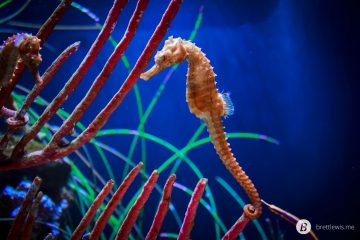Since most of the males in the animal kingdom don’t have access to DNA tests, many species have found ways of ensuring their biological fatherhood. A great example of this comes from the seahorse. But before I discuss reproduction, let’s look at seahorse courtship behaviour.
By human standards, seahorse courtship is viewed as very romantic. They are monogamous with one partner for their whole lives. Every day they meet in the male’s territory and perform a sort of dance where they may circle each other or an object, change colour, and even hold tails. When the female is ready to transfer her eggs and the male is ready to accept, mating begins.

Photo Credit: Brett Lewis
The female seahorse has an ovipositor, which is a tube through which the eggs can be deposited outside the body. The female will deposit her eggs into the male’s brood pouch; this is a pouch where the eggs can grow and receive all the nutrients and oxygen they need, much like fetal mammals do in their mother’s uterus. Once the eggs are in the male seahorses brood pouch, he will fertilize the eggs and allow them to mature for about 24 days. Then the male will give birth to self-sufficient offspring and the courtship and mating cycle will begin once again. Through this type of reproductive process, the male knows that the eggs in his brood pouch are his children.
Interested in learning more about the mating behaviours of different plants, animals, and fungi? Check back here for more Mating Mondays.
Seahorses are actually endangered. Please visit Project Seahorse to learn more about how to protect them.
Interested in learning more about the mating behaviours of different plants, animals, and fungi? Check back here for more Mating Mondays.
For more information about fish, check out the fish collection.
